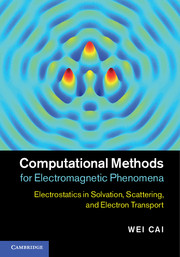 Computational Methods for Electromagnetic Phenomena
Computational Methods for Electromagnetic Phenomena from Part III - Electron transport
Published online by Cambridge University Press: 05 February 2013
The transport of carriers (electrons and holes) in semiconductor devices such as hetero-junctions, MOSFETs, and superlattices can be described by classical hydrodynamics, drift diffusion models, or semi-classical models (Boltzmann equations) when the devices are of micron or sub-micron scales, and by quantum models (such as Wigner distributions) for devices at nano-scales. The key factor in selecting a specific proper transport model is the mean free path of the carriers inside a device in comparison to the size of the device.
In this chapter, we present an overview of quantum transport models, firstly by deriving the Fermi–Dirac distribution for electrons in an equilibrium system using quantum ensemble theories. Secondly, we define the density matrix for nano-devices, Wigner distributions, and Wigner–Moyal expansions. The Landauer transmission theory for quantum transport models will be reviewed. Finally, the non-equilibrium Green's function (NEGF) method is introduced for computing the transmission coefficients of quantum devices. The semi-classical Boltzmann model, the classical hydrodynamic models, and their numerical methods, will be discussed in Chapter 15. For Part III of this book, the time dependence of a time-harmonic wave function in the Schrödinger equation will be assumed to be in the form e−iEt/ħ for reasons of convention.
Ensemble theory for quantum systems
Thermal equilibrium of a quantum system
For a quantum subsystem S with given macroscopic state variables such as the particle number N, the overall energy E, and the volume V, Ω(N, V,E) denotes the number of quantum states (also called microstates) accessible to S.
To save this book to your Kindle, first ensure [email protected] is added to your Approved Personal Document E-mail List under your Personal Document Settings on the Manage Your Content and Devices page of your Amazon account. Then enter the ‘name’ part of your Kindle email address below. Find out more about saving to your Kindle.
Note you can select to save to either the @free.kindle.com or @kindle.com variations. ‘@free.kindle.com’ emails are free but can only be saved to your device when it is connected to wi-fi. ‘@kindle.com’ emails can be delivered even when you are not connected to wi-fi, but note that service fees apply.
Find out more about the Kindle Personal Document Service.
To save content items to your account, please confirm that you agree to abide by our usage policies. If this is the first time you use this feature, you will be asked to authorise Cambridge Core to connect with your account. Find out more about saving content to Dropbox.
To save content items to your account, please confirm that you agree to abide by our usage policies. If this is the first time you use this feature, you will be asked to authorise Cambridge Core to connect with your account. Find out more about saving content to Google Drive.